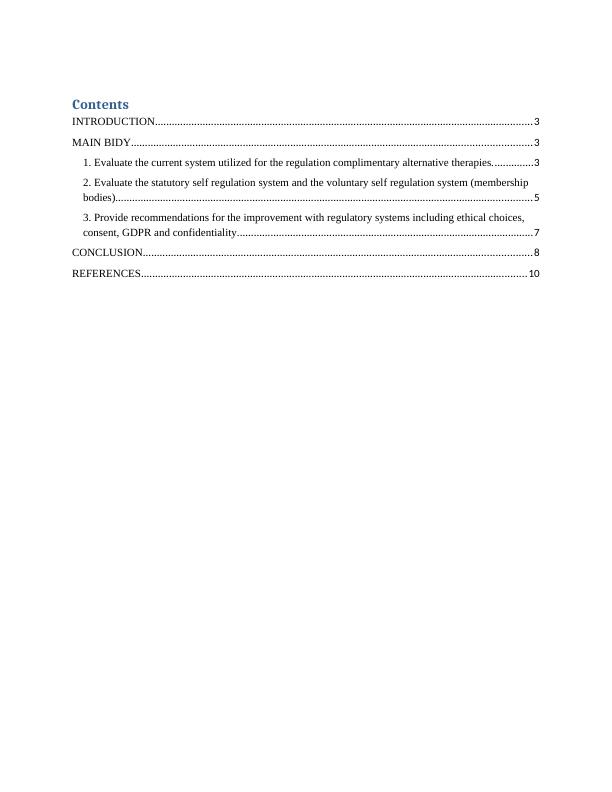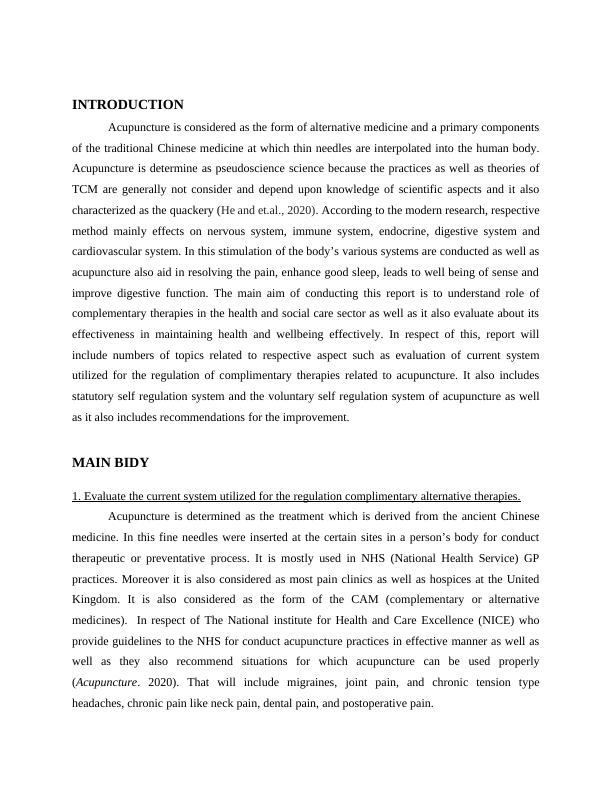Regulation of Acupuncture: Evaluation and Recommendations
Added on 2023-01-09
10 Pages3205 Words93 Views
Acupuncture

Contents
INTRODUCTION.......................................................................................................................................3
MAIN BIDY...............................................................................................................................................3
1. Evaluate the current system utilized for the regulation complimentary alternative therapies...............3
2. Evaluate the statutory self regulation system and the voluntary self regulation system (membership
bodies).....................................................................................................................................................5
3. Provide recommendations for the improvement with regulatory systems including ethical choices,
consent, GDPR and confidentiality..........................................................................................................7
CONCLUSION...........................................................................................................................................8
REFERENCES..........................................................................................................................................10
INTRODUCTION.......................................................................................................................................3
MAIN BIDY...............................................................................................................................................3
1. Evaluate the current system utilized for the regulation complimentary alternative therapies...............3
2. Evaluate the statutory self regulation system and the voluntary self regulation system (membership
bodies).....................................................................................................................................................5
3. Provide recommendations for the improvement with regulatory systems including ethical choices,
consent, GDPR and confidentiality..........................................................................................................7
CONCLUSION...........................................................................................................................................8
REFERENCES..........................................................................................................................................10

INTRODUCTION
Acupuncture is considered as the form of alternative medicine and a primary components
of the traditional Chinese medicine at which thin needles are interpolated into the human body.
Acupuncture is determine as pseudoscience science because the practices as well as theories of
TCM are generally not consider and depend upon knowledge of scientific aspects and it also
characterized as the quackery (He and et.al., 2020). According to the modern research, respective
method mainly effects on nervous system, immune system, endocrine, digestive system and
cardiovascular system. In this stimulation of the body’s various systems are conducted as well as
acupuncture also aid in resolving the pain, enhance good sleep, leads to well being of sense and
improve digestive function. The main aim of conducting this report is to understand role of
complementary therapies in the health and social care sector as well as it also evaluate about its
effectiveness in maintaining health and wellbeing effectively. In respect of this, report will
include numbers of topics related to respective aspect such as evaluation of current system
utilized for the regulation of complimentary therapies related to acupuncture. It also includes
statutory self regulation system and the voluntary self regulation system of acupuncture as well
as it also includes recommendations for the improvement.
MAIN BIDY
1. Evaluate the current system utilized for the regulation complimentary alternative therapies.
Acupuncture is determined as the treatment which is derived from the ancient Chinese
medicine. In this fine needles were inserted at the certain sites in a person’s body for conduct
therapeutic or preventative process. It is mostly used in NHS (National Health Service) GP
practices. Moreover it is also considered as most pain clinics as well as hospices at the United
Kingdom. It is also considered as the form of the CAM (complementary or alternative
medicines). In respect of The National institute for Health and Care Excellence (NICE) who
provide guidelines to the NHS for conduct acupuncture practices in effective manner as well as
well as they also recommend situations for which acupuncture can be used properly
(Acupuncture. 2020). That will include migraines, joint pain, and chronic tension type
headaches, chronic pain like neck pain, dental pain, and postoperative pain.
Acupuncture is considered as the form of alternative medicine and a primary components
of the traditional Chinese medicine at which thin needles are interpolated into the human body.
Acupuncture is determine as pseudoscience science because the practices as well as theories of
TCM are generally not consider and depend upon knowledge of scientific aspects and it also
characterized as the quackery (He and et.al., 2020). According to the modern research, respective
method mainly effects on nervous system, immune system, endocrine, digestive system and
cardiovascular system. In this stimulation of the body’s various systems are conducted as well as
acupuncture also aid in resolving the pain, enhance good sleep, leads to well being of sense and
improve digestive function. The main aim of conducting this report is to understand role of
complementary therapies in the health and social care sector as well as it also evaluate about its
effectiveness in maintaining health and wellbeing effectively. In respect of this, report will
include numbers of topics related to respective aspect such as evaluation of current system
utilized for the regulation of complimentary therapies related to acupuncture. It also includes
statutory self regulation system and the voluntary self regulation system of acupuncture as well
as it also includes recommendations for the improvement.
MAIN BIDY
1. Evaluate the current system utilized for the regulation complimentary alternative therapies.
Acupuncture is determined as the treatment which is derived from the ancient Chinese
medicine. In this fine needles were inserted at the certain sites in a person’s body for conduct
therapeutic or preventative process. It is mostly used in NHS (National Health Service) GP
practices. Moreover it is also considered as most pain clinics as well as hospices at the United
Kingdom. It is also considered as the form of the CAM (complementary or alternative
medicines). In respect of The National institute for Health and Care Excellence (NICE) who
provide guidelines to the NHS for conduct acupuncture practices in effective manner as well as
well as they also recommend situations for which acupuncture can be used properly
(Acupuncture. 2020). That will include migraines, joint pain, and chronic tension type
headaches, chronic pain like neck pain, dental pain, and postoperative pain.

End of preview
Want to access all the pages? Upload your documents or become a member.
Related Documents
Complementary Therapies: Positive Aspects of Acupuncturelg...
|7
|2121
|110
Understanding the Mechanism of Action of Western Acupuncture for Muscular Systemlg...
|16
|5101
|472
Acupuncture: History, Uses, and Side Effectslg...
|6
|1486
|61
Acupuncture: History, Uses, and Side Effectslg...
|6
|1464
|84
Role of Complementary Therapies in Relation to Orthodox Treatmentslg...
|18
|1351
|36
Complementary Therapies: Analysis of Massage Therapylg...
|13
|3808
|493